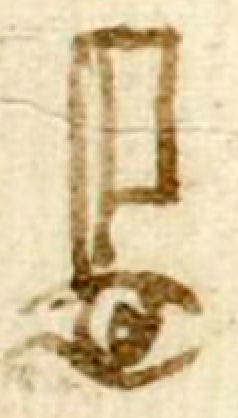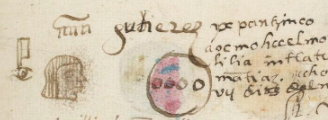Ixpantzinco (TV4r)
This black-line drawing of the compound glyph for the personal name Ixpantzinco (“In Front Of," attested here as a man's name), shows a frontal view of a leaf-shaped eye (ixtli) painted in a European style. Above the eye is an upright white banner (panitl) flying toward the viewer's right. The reverential, locative suffix (-tzinco) is not shown visually.
Stephanie Wood
The two elements of this compound both have a phonetic role intending the word ixpan, which means "before" or "in front of," making it a fully phonographic compound. The man with this "name" also has another name, Martín Gutiérrez. In fact, if it were not for the nature of the glyph, one might have expected the "ixpantzinco" preposition to be referring to his location in front of someone of authority.
Stephanie Wood
yxpantzinco
Ixpantzinco
Stephanie Wood
1574
Jeff Haskett-Wood
preposición, ante, nombres de hombres

ixpan, in front of, https://nahuatl.wired-humanities.org/content/ixpan
ix(tli), eye, https://nahuatl.wired-humanities.org/content/ixtli
pan(itl), flag or banner, https://nahuatl.wired-humanities.org/content/panitl
-tzin, reverential suffix, https://nahuatl.wired-humanities.org/content/tzin
Delante de
Stephanie Wood
El Libro de los Tributos de San Pablo Teocaltitlan, also known as the Codex Valeriano and Manuscrit Mexicain 376, is hosted by the Bibliothèque nationale de France, published on line in the digital resource, Gallica, https://gallica.bnf.fr/ark:/12148/btv1b8455947h/f15.item.r=Libro%20de%20...
The non-commercial reuse of images from the Bibliothèque nationale de France is free as long as the user is in compliance with the legislation in force and provides the citation: “Source gallica.bnf.fr / Bibliothèque nationale de France” or “Source gallica.bnf.fr / BnF.” We would also appreciate a citation to the Visual Lexicon of Aztec Hieroglyphs, https://aztecglyphs.wired-humanities.org/.



